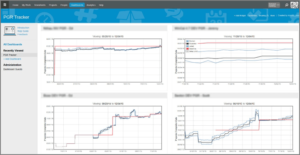Company
Note: This company does not allow its name to be used for third-party marketing purposes. However, as a satisfied LiquidPlanner user, it has agreed to share its experiences with LiquidPlanner anonymously.
Company A manufactures semiconductor test and measurement equipment in several global locations. With nearly 500 employees and offices in several countries, the company supports nearly 1000 integrated circuit design and development customers.
Challenge
In the past, even though Company A had a formal project management office (PMO), it did not have a formal project/work management solution. Instead, each new development effort, IT upgrade, facilities move, and other major project chose its own means of estimating projects, allocating resources, and tracking progress. This resulted in a range of tools that included Microsoft Project, Basecamp, Smartsheet, Visio, and Excel—with the data for each project residing within its own location.
Lack of a uniform approach to project management presented several challenges. “Our biggest problem was not understanding the full scope of all projects and who was working on them,” says the company’s Project Manage-ment Office (PMO) Director. “Resource allocation across projects was difficult or impossible—and we needed a lot of help making it clearer what project priorities were; everybody had a different idea of what was the most important.”
In turn, these problems often resulted in missed delivery dates. “Without a full picture of all projects and resource constraints, we were always too optimistic in our schedules,” says the PMO Director. “Our strategic plan depends heavily on new product development, the cycles for which can take 18 months. If we miss projected delivery dates, then we also run the risk of missing our revenue targets two or three years out.”
The PMO team had held several discussions about adopting a standardized project management tool, but had yet to find a compelling solution. “We needed something that was easy to adopt and learn, had low implementation and ongoing costs, and provided the core group of features we desired,” recalls the PMO Director.
Solution
While Company A was interviewing a job candidate for an engineering position, the candidate mentioned that his previous company had used LiquidPlanner with considerable success. After doing her own research, in which the PMO Director compared LiquidPlanner to several other tools, she decided to pilot it with a small team. “LiquidPlanner is subscription-based, so I saw little financial risk to trying it out,” she says.
Company A piloted LiquidPlanner from August to December 2014, using it on three small projects. “We had two project managers and 8-10 other people using LiquidPlanner during that time,” recalls the PMO Director. “I chose influencers within the company so that, if all went well, they could help fuel broader adoption. We found LiquidPlanner fairly easy to adopt; the guides and training videos on their website helped a lot.”
In January 2015, Company A decided to broadly deploy LiquidPlanner. “LiquidPlanner delivered what we needed—more so than any other solution we had found,” says the PMO Director. “It gave us deep, real-time visibility and transparency into project status. Even more important, it gave us that same view across all projects—including resource constraints and the ability to pose ‘what if’ questions—such as the effect that a custom development effort for one customer would have on delivery dates for other projects.”
Today, Company A has more than 15 major project teams using LiquidPlanner, along with many additional, smaller teams. “Of our 150 LiquidPlanner users, about 80 percent use it on a daily basis,” says the PMO Director “The first group to adopt it was the Engineering R&D organization. Following that, we rolled it out to our Center of Excellence, Trade Compliance and Logistics team, and Supply Chain team.”
The PMO Director is presently supporting adoption by additional teams. “Our Accounting department plans to use LiquidPlanner to manage their end-of-month and end-of-quarter processes instead of Excel,” she explains. “Beyond that, I plan to roll it out fully to our Marketing and IT organizations. Momentum is strong, people want in, and they’re proactively asking for licenses.”
The range of uses that Company A has found for LiquidPlanner are just as diverse as its user base. “If you can name it, we’ve likely found a way to use LiquidPlanner to improve it,” says the PMO Director. “We’re using LiquidPlanner for everything from software and hardware development to process improvement, facilities moves and buildouts, implementation of new IT software, and field support.”
Of all the features provided by LiquidPlanner, the PMO team is finding several to be particularly valuable:
- Best case/worst case estimates, which help Company A take uncertainty into account when estimating the tasks within a project.
- Predictive, priority-based scheduling, which dynamically recalculates the most likely completion date for all tasks and projects, taking into account past history as well as each resource’s availability, priorities, vacations, and other factors.
- Automatic resource leveling, which prevents the overallocation of resources across one or more projects.
- Timesheets, which enable Company A to capture who worked on what as each task is completed, instead of when biweekly timesheets are submitted.
- LiquidPlanner Dashboards, which provide at-a-glance visibility into project status—including early warning signs that a project may be headed off-track.
- Advanced reporting and analytics — especially the Date Drift graph in LiquidPlanner, which, according to the PMO Director, “Is awesome because it helps us see very early if there’s a problem with a project and if we’re in danger of missing a commitment.”
Benefits
Company A is benefiting from its use of LiquidPlanner in several ways, including improved visibility into project status, more accurate project estimation, and a better understanding of resource utilization and constraints. Everyone is now on the same page with respect to priorities, and the company is well-positioned to optimize its project management methodologies and processes. On top of all this, project managers are spending less time collecting project status, leaving more time to take action where needed.
Improved Visibility Into Project Status
Company A now has an accurate picture of all projects, including work completed, work remaining, and likely milestone and project completion dates. “LiquidPlanner has helped us greatly improve visibility and transparency into project status; project teams can no longer pretend they’re on track—or lead themselves to believe so—when they’re not,” says the PMO Director. “It’s all priority-, effort-, and resource-based, which takes a lot of the guesswork, emotion, and politics out of the equation.”
Full Understanding of Resource Utilization and Constraints
Before LiquidPlanner, Company A had no concrete way to understand resource utilization and constraints—especially across projects, and as priorities changed. Now it does. “Today, it’s abundantly clear when a project due date slips due to a resource constraint,” says the PMO Director. “This is a key benefit of using LiquidPlanner, but you have to go ‘all-in’ to achieve that benefit.”
Improved Project Estimation
With the first round of major projects using LiquidPlanner still underway, the PMO Director does not yet have hard data to quantify how LiquidPlanner has helped improve project estimation. However, all signs are good. “We’re just now launching new project phases that were fully planned using LiquidPlanner,” admits the PMO Director. “That said, given that we’re using LiquidPlanner to achieve a consistent project process and scheduling methodology, with built-in resource leveling, I expect our project estimates to become much more accurate.”

Company A’s LiquidPlanner Dashboard shows the status of critical projects at a glance.
Granular Time Tracking
In the past, Company A attempted to track how much time people worked on various tasks in its payroll system—with limited success. Today, the company uses LiquidPlanner’s timesheet features to capture that information more accurately, more easily, and in near-real-time. “We need to track our time to ensure we are allocating resources according to our strategic plans,” says the PMO Director. “We were attempting to do that in our payroll system, but it wasn’t working all that well. Timesheet entry in LiquidPlanner is a huge benefit because it lets us capture and track that information on a daily basis, versus relying on people to accurately recall how they spent every hour of the past two weeks before filling out their timesheets.”
Improved Productivity for Project Managers
Project managers no longer need to manually follow-up on as many details to get an accurate picture of project status, which has freed their time for more important tasks. “Our LiquidPlanner Dashboard shows the status of our 13 most critical projects at a glance,” says the PMO Director. “And with effort against tasks tracked until those tasks are marked complete, everyone can see what progress is being made. Project managers no longer sit in status meetings asking everyone what they’ve accomplished since they last met. Instead, they’ve been able to shift that time from collecting information to acting on it.”
Consistent Understanding of Priorities
With LiquidPlanner, Company A can now enforce a consistent set of project priorities—with full visibility into how everybody is working toward those goals. “Not only can we see the status of all projects at a glance, we can easily discern the impact of new work—such as a custom development project for a client,” says the PMO Director. “And if we want to evaluate changing priorities, LiquidPlanner recalculates all delivery dates to show us the impact. I love LiquidPlanner; it can and will add tremendous value as we continue to roll it out. Even if only my four project managers were using it, we would still be a lot better off than before.”

